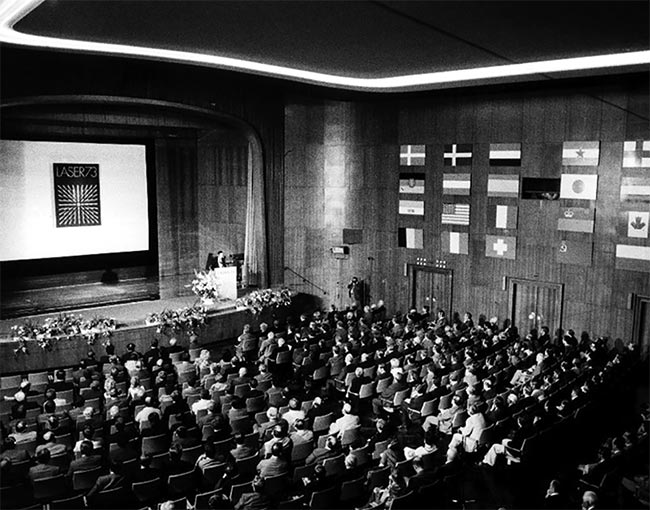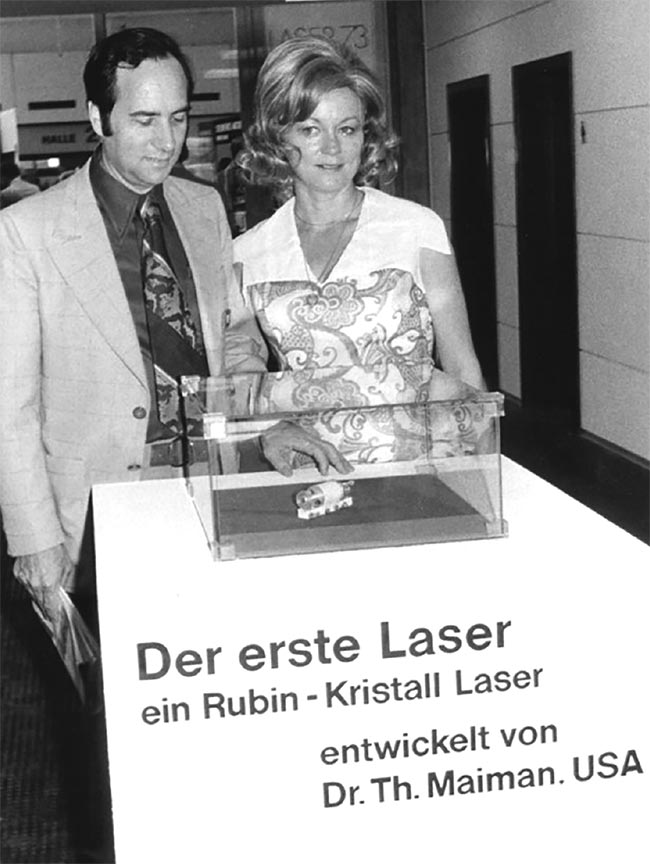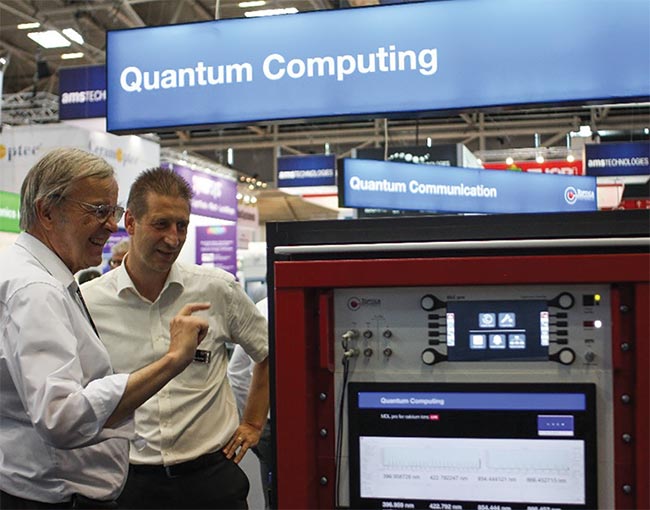ANDREAS THOSS, CONTRIBUTING EDITOR
It was quite a brave decision to start a trade fair for a technology that, at the time, was seen as “a solution seeking a problem.” But in 1973, expectations were high that the emerging field of laser technology would have wide-
ranging impacts on a multitude of applications and end markets. And so, the LASER 73 Fair was founded in Munich, Germany, where it attracted 164 exhibitors.
The event has since expanded and evolved into what is today called LASER World of PHOTONICS, a massive biannual industry tradeshow and scientific congress that, before COVID struck, was drawing over 1300 exhibitors from 40 different countries and 34,000 attendees. Today, few other purely photonic industry events come close to the scale of the event.

In 1973, the international laser community met in Munich for a lively exchange — without the need for internet or PowerPoint slides. Copyright Messe München.
Photonics Media contributing editor Andreas Thoss recently spoke with Anke Odouli, the exhibition director of LASER World of PHOTONICS, and Wilhelm Kaenders, founder of
TOPTICA Photonics AG and chairman of the event’s Exhibitor Advisory Board, about how this trade show became the biggest laser and photonics trade fair and what is coming next. Below is a lightly edited transcript of their discussion.
AT: Anke, who were the founders of LASER World of PHOTONICS, and why did they create this trade show?
AO: When LASER Munich, as most people call the trade fair, was founded, Gerd vom Hövel was the managing director of Messe München. The laser had been invented just one decade before, and many people expected it to be “the next big thing.” Still, it was much more a subject of scientific studies than of industrial products.
But vom Hövel was a very visionary manager and started an entirely new trade fair, even when the actual market was still small. In order to compensate for the lack of industry exhibitors, they implemented a scientific congress and called the whole event a “Kongress-Messe” [Congress Fair].

Laser technology in 1973 was still so new at the time that early LASER Munich attendees were excited to look inside the box. Soviet Russian Nobel laureate Alexander Prokhorov and American physicist Theodore Maiman enjoy the presentation of an early argon laser pumping a dye laser. Copyright Messe München.

Theodore Maiman, here with his wife, Shirley Rich Maiman, presented his invention at LASER 1973 for the first time abroad. Today, this laser is a valuable exhibit in Munich’s Deutsches Museum. Copyright Messe München.
The combination was highly valued.
Laser Nobel laureate Alexander Prokhorov and the laser’s inventor Theodore Maiman came to Munich to give speeches at the opening event. I was told that it was actually the very first time that Maiman left the U.S.
Just two years later, vom Hövel started the new format “productronica” as a first trade fair targeting automation in production. So, there was ambition and entrepreneurship on his part to pick up the latest technological trends and to start new trade shows in the early 1970s here in Munich. Later, Automatica was added to the portfolio, the leading exhibition for smart automation and robotics, which is now co-located with LASER Munich.
AT: Wilhelm, when was your actual first visit to this trade show and how was your experience back then?
WK: My first appearance there was in 1995 when I was drawn from my university position into the role of starting a new business in the company that’s now called TOPTICA Photonics.
At that time, we were brave enough to put an experimental setup in our booth. It was a rubidium saturation spectroscopy setup that you can see now demonstrated in many places. Our booth was at the drafty entrance position in one of the halls
with all the excitement that was happening there.
AT: May be a windy spot, but certainly a good one to be seen at the show. Anke, what has changed in those 50 years?
AO: The number of exhibitors to start with. The internationality has not changed because already in 1973, the LASER show was highly international. At LASER 73 we had 164 exhibitors and 47% of them were from abroad, including Professor Maiman and his ruby laser.
What has changed compared to ’73? First of all, we moved to a different location; we are at the old airport grounds in Munich Riem now, where a completely new fairground had been built 25 years ago, with halls that are now big enough for the show. The show has grown by quite some numbers. The congress has grown to be the largest photonics event in Europe with our partners from the scientific associations.
What else has changed? We started, in 2022, our first edition of the World of QUANTUM trade fair to highlight quantum technology enabled by photonics. Our basic idea for setting up World of QUANTUM was for it to be an independent trade fair taking place in parallel with LASER World of PHOTONICS.
Furthermore, the trade fair Automatica will be taking place in parallel in 2023. Any industrial application was more of a promise than a reality in 1973. Now, laser technology has arrived on the shop floor and robotic technology is just a natural fit to it. Thus, we do see a lot of synergies between the two shows.
AT: Wilhelm, what do you see as an exhibitor and as a visitor? What has changed at least in the last 25 years?
WK: I think the congress played an important role in establishing the LASER fair and the exchanges between scientists and the people on the application side. The advisory board was very important for that goal. Professor Wilhelm Waidelich,
a medical laser expert, was [the congress’s] first chairperson. I think another central figure for the establishment of
the congress was Professor Herbert Walther.
They took care of the event from an academic standpoint. When the congress became the venue of the OSA/CLEO Europe Congress in 2003 — also with the support of the BMBF [German Federal Ministry of Education and Research] — this changed the event quite a bit. CLEO Europe had moved around Europe before, so the decision to stay in Munich was a distinction, for our mutual benefit, as we see now.
I think that the world-leading character of the event has been growing more and more. Of course, Photonics West is a big competitor, but it seems to me that the
effort that companies make to have their latest inventions every two years at LASER is certainly at a much more complex and a much more ambitious level than what I can see at Photonics West, although that show is more repetitive with its annual term.
AT: I think that the congress is something unique because there are six or seven different societies holding their conference at one spot, which allows people to move across the whole field of photonics. This makes it different from any other conference, with topics ranging from production over theoretical findings to biophotonics and other fields that are just arising.
Now, if we try to look into the future, what would you say? How might LASER World of PHOTONICS look in 20 years? What trends are changing the landscape now?
"In the beginning, the laser as we all know was something that was looking for an application. Right now, the applications are looking for a laser that fits." ~Wilhelm Kaenders
AO: I think that meeting in person will continue to be substantial. That is the lesson we learned within the last three years during the corona pandemic when we were not able to travel and to network with people directly.
If we look at laser technology, there might be two trends: On the one hand,
the laser will become even more relevant for daily life. Lidar and AR/VR are some key words here. On the other hand, the laser will conquer even more industrial application fields. For this reason, the
co-location with Automatica may lead to more synergies. This could become even more important in the next 20 years.
Then, of course, sustainability is a big issue. What photonics in general can add to this very important topic is substantial. Laser fusion could be another example, even if it is not practical at the moment. I’m sure there are also other new things coming up.
WK: In the past, lasers were basically optomechanics. Many of these basic optomechanic setups are being replaced over time by semiconductors and by fiber lasers. So, the mechanical construction part has lost importance and lasers have entered huge consumer markets.
In the beginning, the laser as we all know was something that was looking
for an application. Right now, the
applications are looking for a laser that fits. I think that’s also typical for the current trade show visitor who is looking for a machine that solves his application need.
People are more agnostic also about what kind of laser technology they use — as long as it fulfills the need. Quality, robustness, and scalability are topics now that are addressed much more on the LASER show than they were in the past. Then, it was more the general ability to perform certain specifications. Right now, you need to do that also in a reliable long-term fashion.
AT: Would you agree that some fields in photonics, such as laser material processing, are becoming mature enough that suppliers serve a very broad market, while other fields are just arising, such as quantum?
WK: I think there will always be new fields arising, but today that’s less on the laser side. I think laser technology as such is now in a more or less defined stage. Of course, the application field will be getting larger as we try to squeeze more power out of ever-smaller lasers.

LASER Munich is a good place to meet Nobel Prize winners such as Ted Hänsch (left). They just can’t open the laser box as easily as they could 50 years ago. Copyright TOPTICA Photonics AG.
Still, some technologies may need different specifications. Quantum technologies, for example, need high-quality photons, and thus they try to control the laser light on the level of single photons.
AT: If we change the angle, where do you see LASER Munich in the context of global markets?
WK: The positioning of LASER here in Munich is important also for the global competition. While we see a growing
rivalry between the U.S. and China, I think it is good to have somebody that so far has been able to work with both sides, even opening up for the eastern countries.
AT: You touch on an interesting point. During the pandemic, I had a number of discussions with people who suspected that conventions could develop more locally so
that people could avoid crossing borders that imposed large restrictions. How good that those restrictions have fallen.
AO: Indeed, and I can already tell you that the numbers of exhibitors from China applying for LASER 2023 have increased by 5 or 6× compared to 2022. We are on our way back to the numbers from 2019, which was the biggest LASER trade fair ever. This year, it will definitely be as
“international” as it was in 2019.